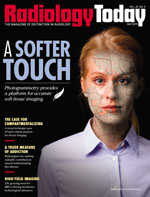 Editor’s Note: Effective Measures
Editor’s Note: Effective Measures
By Dave Yeager
Radiology Today
Vol. 20 No. 5 P. 3
Some things are more difficult to measure than others. For example, what’s the most accurate way to quantify a person’s level of sports fandom or objectively rank the lightsaber battles from the Star Wars movies? Radiology often runs into measurement difficulties as well, such as determining the most accurate means of describing breast nodules or digitally recreating soft tissue for 3D printing. This month’s issue considers some of the ways that finer measurements can advance medical practice.
In our cover feature, Kathy Hardy explores the use of photogrammetry to help image soft tissue and produce more lifelike prosthetics; soft tissue presents a particular challenge to medical imagers because its shape changes with facial expressions and the prosthetics need to be pliable. The photogrammetry technique was pioneered at Walter Reed Army Medical Center to help soldiers who had suffered disfiguring injuries. It’s being used now to help people from all walks of life. Hardy interviews some of the people who helped develop and refine it.
Another new technique, this one for breast imaging, is called three-compartment breast (3CB) imaging. 3CB provides quantitative measurements of water, lipid, and protein thicknesses throughout the breast. Combined with radiomics—AI analysis of the quantitative features—3CB shows promise for reducing the number of unnecessary breast biopsies. As Beth W. Orenstein reports, the current biopsy rate is approximately 10% of recalls, and only around 30% of biopsies result in a cancer finding. Reducing that number is a worthy goal.
Speaking of worthy goals, many researchers are using medical imaging to better understand addiction. Once consigned purely to the realm of psychology, new evidence is emerging for a biological basis underlying addiction, a development that will hopefully uncover new targets for treatment and help to erase the stigma associated with the disease. Jeannette Sabatini looks at some of the latest research and speaks with some of the investigators who are at its leading edge.
Finally, Keith Loria takes the measure of the MRI market. Many exciting advances in the MRI field are improving its utility and versatility. As Loria notes in the article, the demand for MRI is growing, and manufacturers are doing their best to keep pace. To find out what they’re up to, check out the feature on page 22.
Enjoy the issue.
david.yeager@gvpub.com

